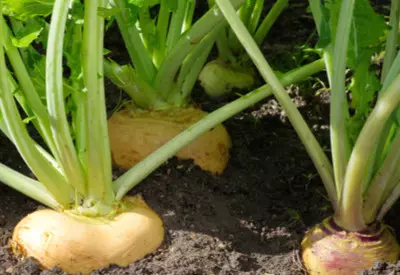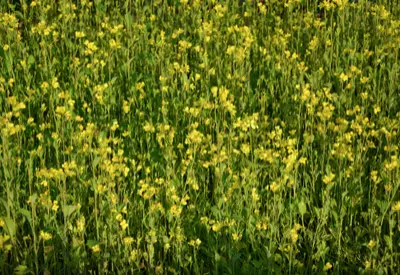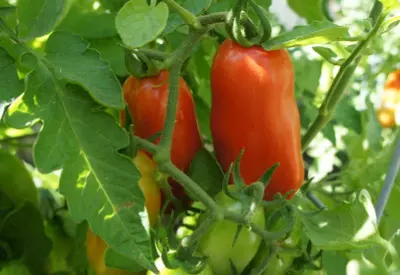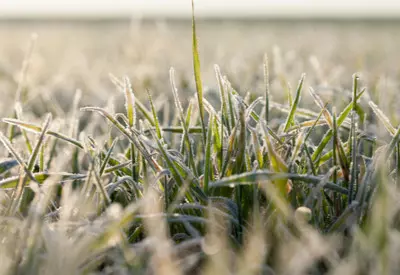You asked and here it is : the ultimate cover crop guide for what to plant to protect and recharge your garden!

You might be surprised to find turnips included in our ultimate cover crop guide!
For years, we have been singing the praises of planting cover crops in the garden. They are essential for protecting gardens.
They help keep weed seeds out and stop the loss of valuable topsoil through erosion. Most importantly, they recharge and rebuild tired garden soil after a long season of growing vegetable crops. See : No Till Garden Cover Crops
With a wide range of selections to choose from, choosing the right cover crop to grow can be confusing.
Some are better for fixing nitrogen levels. Others are great for breaking up hardened soils. And still more are good for growing in dry or wet conditions.
So for this week’s gardening article, we break down 7 of the best cover crops to use. It is our ultimate cover crop guide for gardens everywhere.
The Ultimate Cover Crop Guide – Top Varieties To Recharge Garden Soil
Winter (Annual) Rye
Our number one choice when it comes to cover crops. Winter rye grass is the perfect choice as an over-wintering cover crop, weather for a traditional garden, or a Raised Row, no-till garden.

Topping our cover crop guide list – annual rye!
It is quick to germinate, and the dense, thick coat smothers out any and all weed seeds looking for a spot to hibernate.
The root structure of annual rye is only a few inches deep, but contains an extensive network that fixes nitrogen in the soil, making it available for next year’s vegetable plants.
To plant, lightly rake soil and sow seeds. Rake again to help scratch into the soil. The seeds do not have to be completely covered in soil to germinate and grow.
Winter rye germinates quickly, usually within 7 to 10 days. The crop goes dormant in the winter months. and will re-emerge to grow in the spring before dying off before planting.
Never allow a crop to grow high enough to form seed. If the rye grows to more than 6 inches, mow to keep from forming seeds. The clippings are great for the compost bin. They can also be left in the garden to decompose.
It will take 3 to 5 cuttings in spring before the winter rye completely dies back. It can be directly planted through without tilling. Seed Link : Winter (Cereal Rye) Seed
Buckwheat
Buckwheat is a fast-growing broadleaf plant and a wonderful cover crop choice.
It is a perfect choice for those who have thick weed problems. It suppresses the most stubborn of weeds, including quackgrass and crabgrass.
Buckwheat grows quickly and is best planted in the cooler temperatures of mid to late fall. It matures in 6-8 weeks. This makes it ideal for a late fall planting before the winter weather arrives. It is also great to plant as a quick “green manure crop” in the early spring before planting vegetables like tomatoes and peppers.

Mustard seed growing as a cover crop.
In the fall, plant buckwheat 45 days before your first annual frost date. The buckwheat dies off completely over winter, but can be left to cover the rows until ready to plant. Simply mow off, and plant through when ready.
If planting in Spring or Summer for a green manure crop, plant and then mow off before you are ready to plant the next crop. Allow the crop to mature for at least 40 days for a green manure crop. Seed Link : Buckwheat Seed
Mustard
Yes, believe it or not, mustard seed is an excellent garden cover crop!
Mustard is fast growing, and a good weed suppression crop. It also is a great choice for suppressing soil-borne pests and diseases. .
Broadcast seeds at a depth of ½ inch about 6 weeks prior to last frost date. This allows enough time for the seed to become established.
Mustard will cover the garden with a thick coat of foliage. It will die completely back in the winter and can be planted through after mowing in the spring. Seed Link : Mustard Seed
Crimson Clover
Crimson clover is a legume that grows well in fertile, well-drained soil. It is a great choice for established gardens needing to replace lost nutrients.

Vegetables like tomatoes take a lot of nutrients out of the soil.
It germinates and grows fast, and can be used as a overwinter cover crop, or even a summer cover crop in between spring and fall crops.
For use as a fall cover crop, seed 6-8 weeks before the first frost date. Crimson clover dies off in the winter in cold climates. Sow seed liberally and rake into the soil.
Be sure you are choosing crimson clover, and not red clover. The leaves and stems resemble red clover but crimson leaves are more rounded and appear to be hairy along the stems.
Like winter rye, it can be mowed off and planted through without having to till soil. Seed Link : Crimson Clover Seed
Annual Oats
Annual oats are an excellent choice for gardens prone to excessive rain and moisture.
Their root system and foliage canopy are one of the best choices of cover crops to prevent soil erosion. Annual oats are also great for providing organic material back into the soil.
Annual oats are not winter hardy, so plant in late summer or early fall so the crop can become established. Common pairings for an annual oat cover crop include radishes, turnips and clover.

Cover crops protect garden soil from the harshness of winter
As winter approaches and the oats die off, you may need to add straw or shredded leaves to help protect your soil from weed seeds.
To plant, lightly rake the soil surface and sow seeds on top of the soil. Lightly rake the seeds to set in the soil. Product Link : Cover Crop Seed
Turnips
Although turnips are a true garden crop that can be harvested, they are also an excellent cover crop. When planted as a cover crop, leave the crop in place to decompose. As they grow, they break up the soil. Then, as they decompose, they release their nutrients back in to the soil,
Their thick roots and turnip cores are great for loosening hard and compacted soil. They are easy to plant, and good for raised beds and all garden set ups.
Although turnips hold up against a light frost, plant in early fall to allow for adequate growth before winter. Plant seeds 1/2 inch deep, a few inches apart from each other to ensure full coverage.
Allow the turnip bulbs to stay in the ground through the winter. They will begin to decay by planting time, leaving behind a more fertile and aerated soil. Product Link : Turnip Seeds
Hairy Vetch
Hairy Vetch is another great choice to recharge vegetable garden soil.
It is the cover crop of choice for problem soils and climates. It is excellent at fixing nitrogen levels in the soil, so a great choice for tired and lifeless soils.
Hairy vetch works well in cold climates and in areas with little rainfall. It is extremely resilient to dry, arid conditions. It also does performs well in soils with high pH levels. Do not plant in areas where excessive moisture is problematic.
Plant in late summer or early fall. Broadcast seeds across the soil surface and rake into the soil lightly. The crop will begin to grow prior to the winter freeze and go dormant. In the spring, it will resume growing.
Cut back using a lawnmower when the crop becomes greater than 6 inches in height. Mow off for the final time prior to planting day. Vegetables can be directly planted through the soil and cover crop. Seed Link : Hairy Vetch Seed
Happy Cover Cropping! Jim and Mary. To receive our 3 Home, Garden, Recipe and Simple Life articles each week, sign up below for our free email list. You can also follow us on Facebook, Twitter, Pinterest, or Instagram. This article may contain affiliate links.
